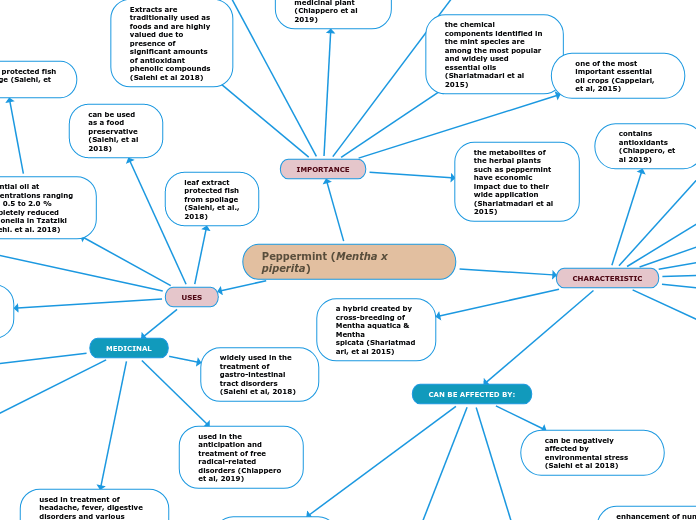Peppermint (Mentha x piperita)
USES
traditionally used in herbal teas and spices in many foods (Salehi, et al, 2018)
essential oil at concentrations ranging from 0.5 to 2.0 % completely reduced salmonella in Tzatziki (Salehi. et al. 2018)
leaf extract protected fish from spoilage (Salehi, et al., 2018)
leaf extract protected fish from spoilage (Salehi, et al., 2018)
can be used as a food preservative (Salehi, et al 2018)
Possible for natural herbicide formulation (Salehi. et al, 2018)
MEDICINAL
known reduction in cancer risk and cardiovascular and neurological diseases (Chiappero et al, 2019)
antipyretic, antispasmodic, analgesic, carminative, diaphoretic, anti-diarrhea, anti-microbial (Chiappero, et al 2019)
used in treatment of headache, fever, digestive disorders and various minor ailments (Salehi et al, 2018)
used in the anticipation and treatment of free radical-related disorders (Chiappero et al, 2019)
widely used in the treatment of gastro-intestinal tract disorders (Salehi et al, 2018)
IMPORTANCE
widely distributed in europe, asia, australia, and north america (Salehi et al 2018)
the chemical components identified in the mint species are among the most popular and widely used essential oils (Shariatmadari et al 2015)
aromatic crop of great economic importance and is utilized as a flavoring agent world-wide as well as being used extensively as a medicinal plant (Chiappero et al 2019)
has a high variability derived from the existence of numerous chemotypes (Salehi et al 2018)
Extracts are traditionally used as foods and are highly valued due to presence of significant amounts of antioxidant phenolic compounds (Salehi et al 2018)
one of the most important essential oil crops (Cappelari, et al, 2015)
the metabolites of the herbal plants such as peppermint have economic impact due to their wide application (Shariatmadari et al 2015)
CHARACTERISTIC
a hybrid created by cross-breeding of Mentha aquatica & Mentha spicata (Shariatmadari, et al 2015)
cannot be profitably grown in tropical and subtropical areas (Salehi, et al 2018)
some principal components from peppermint leaves are phenolic compounds whoch could jave a significant effect in the prevention of numerous degenerative diseases (Chiappero et al 2019)
contains antioxidants (Chiappero, et al 2019)
can be found in multiple and diverse environments (Salehi, et al 2018)
grown in cool to temperate regions (Salehi, et al 2018)
has menthol, high amounts of menthone, isomenthone, methy acetate, menthofuran, carone, limonene (Salehi, et al 2018)
not fussy about soil types (Salehi, et al 2018)
CAN BE AFFECTED BY:
susceptible to exposure to pests and diseases (Salehi et al, 2018)
chemical composition and yield of these essential oil can be affected by several exogenous factors (Shariatmadari et al 2015)
propagation depends on vegetative parts (Salehi et al 2018)
can be negatively affected by environmental stress (Salehi et al 2018)
POSSIBLE WAYS TO IMPROVE PLANT GROWTH
enhancement of number and size of peppermint leaf are of particular importance (Shariatmadari, et al, 2015)
optimum temperature is between 21 and 26 degrees Celsius (Salehi, et al 2018)
requires frequent and adequate irrigation (Salehi, et al 2018)
MICROBIAL
Studies of plant interactions involving arbuscular mycorrhizal (AM) fungi in aromatic plants haveshown increases of plant growth and Essential Oils production (Capalleri, et al 2015)
FERTILIZERS
considered to be one of the most important factors to increase crop yield (Yagoub, et al, 2012)
Intensive farming practices for the purpose of high crop yield and quality traditionally involve the extensive use of fertilizers. (Capalleri, et al 2015)
ORGANIC
Compost
Urea
Moringa Extract
Moringa leaf extract (MLE) is rich with numerous growth hormones, particularly zeatin that has been reported to increase the crops yield in the range of 10-45 %. (Maishanu et al 2017)
being investigated to ascertain its effect on growth and yield of crops and thus can be pro-moted among farmers as a possible supplement or substitute to inorganic fertilizers. (Maishanu et al 2017)
Moringa oleifera as a novel natural biostimulant for plant growth, could play a role in improving drought tolerance in plants under saline condition (Maishanu et al 2017)
It has been reported that foliar application of M. oleifera leaf extract accelerated growth of tomato, peanut, corn and wheat at early vegetative growth stage, improve resis-tance to pests and diseases and enhanced more and larger fruits and generally increase yield by 20 to 35 % (Maishanu et al 2017)
M. oleifera is one of the novel natural biostimulant for plant growth, that play an important role in improving yields nutritional quality and tolerance in plants under adverse condition. (Maishanu et al 2017)
the higher the frequency of moringa application, the greater the increase in plant height, dry matter and yield of the crop. (Maishanu et al 2017)
INORGANIC
NPK
NPK which stands for nitrogen (promotes leaf growth), phosphorus (root, flower, and fruit), and potassium (stemand root growth and protein analysis). (Yagoub, et al, 2012)
125 kg N/ha gives higher dry matter amount and essential oil yield (Salehi, et al 2018)
The most important crop nutrients in agricultural systems are nitrogen (N), phosphorus (P), and potassium (K) (Yagoub, et al 2012)
